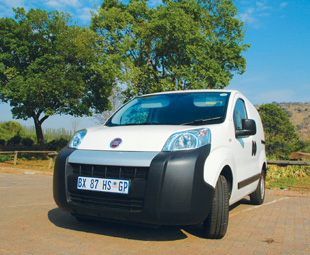Italian stallions

Considering their niftiness, “Italian rapscallions” might be a more appropriate headline – but these two Fiats did leave JACO DE KLERK and GAVIN MYERS feeling that distinctive Italian passion …
FOCUS attended the launch of Fiat’s Fiorino in June, and was pleasantly surprised by the little mover with its well trimmed interior and appealing looks. However, both the 54 kW, 118 Nm 1,4-litre petrol derivative and its diesel counterpart, generating 55 kW at 4 000 r/min and 190 Nm at 1 500 r/min, lacked oomph.
The 1,3-litre diesel unit, using Fiat’s electronically controlled common-rail turbocharged Multijet direct injection system with intercooler, struggled a bit up hills then – but the Italian newcomer got its spunk on when we did a more in-depth test of the vehicle recently.
This time around, the vehicle really came alive to and from Pretoria, OR Tambo International Airport and various other destinations in and around Johannesburg (en route to interviews and events). A slight adjustment in gearshifts and a bit of a heavier foot minimised the turbolag in the hustle and bustle within the cities, making the Fiorino zoom past those driving way below the speed limit on the freeways.
The Fiorino is claimed to achieve fuel consumption of 4,6-litres/100 km, and it certainly was economical; the Fiorino was delivered with a full tank and returned with a quarter of a tank, despite making tracks all over the Gauteng megalopolis for a week.
Another hiccup from the launch test-drive that “disappeared” is the gear lever casing (an extention of the centre consol) that kept on getting in the way of my left knee … During the launch, my knee bumped against the unit numerous times. However, this was solved with a slight adjustment of my driving position and a little time to get use to the
new arrangement.
One minor bother that I didn’t notice in June is the light switch that’s located on the tip of the indicator, not a nuisance in itself, but it resulted in the lights sometimes being switched on and off while indicating. But again, one can learn to avoid this with time.
 A positive that I didn’t originally notice was the ease with which the sliding door (a standard feature on the diesel derivative) can be opened and closed – offering easy access to the 2,5 m2 load volume. This can be increased to 2,8 m2, with a maximum length of 2,5 m, thanks to the stowable front passenger seat.
A positive that I didn’t originally notice was the ease with which the sliding door (a standard feature on the diesel derivative) can be opened and closed – offering easy access to the 2,5 m2 load volume. This can be increased to 2,8 m2, with a maximum length of 2,5 m, thanks to the stowable front passenger seat.
All in all I truly enjoyed the little mover quite a bit. It had me feeling I should be doing some swift deliveries to a bistro in the Italian countryside. At R149 900, including power steering, headlight alignment correctors and central locking, the Fiorino definitely is an attractive offer.
Adding to its appeal is a three-year/100 000 km warranty and the recommended service intervals of one-year/20 000 km.
– Jaco de Klerk
Fiat Doblo Maxi 1,6 MTJ
The Fiorino’s bigger brother, and the middle sibling in the Fiat Professional range, is the Doblo. Like its little brother, the Doblo promises a lot – and delivers.
We had the range-topping R202 000 Maxi 1,6 Multijet (MTJ) on test. As its name suggests, the Maxi is bigger than standard, with a length of 4 740 mm. This has been created by extending the wheelbase by 350 mm to 3 105 mm. The result is a
2 170 mm-long load compartment and 4,2 m3 of load volume. The Doblo Maxi has a 2 370 kg gross vehicle mass (GVM) and a 1 000 kg payload. The rather square load compartment is accessed by a sliding door on both sides of the vehicle and asymmetric 180° opening doors at the rear.
The extended wheelbase also adds to the Doblo’s handling, making it stable on the road, and basically unflappable
in extremis. This will be reassuring to fleet owners, as it does not come with any form of traction or stability control. It is however fitted with ABS and electronic brakeforce distribution (EBD) as well as dual airbags.
 On the point of the brakes, while they are powerful in operation there does not seem to be enough grip from the tyres under emergency braking to maximise stopping capability. However, the rest of the driving experience leaves little to be desired. I find myself surprised when driving a Fiat van (especially the smaller, nippier-feeling Fiorino) as to how similar they feel to Fiat’s passenger cars. You can tell that they were designed by a team of engineers as passionate as those who design the road cars. Well, these are Italian vehicles, and who does passion better than the Italians?
On the point of the brakes, while they are powerful in operation there does not seem to be enough grip from the tyres under emergency braking to maximise stopping capability. However, the rest of the driving experience leaves little to be desired. I find myself surprised when driving a Fiat van (especially the smaller, nippier-feeling Fiorino) as to how similar they feel to Fiat’s passenger cars. You can tell that they were designed by a team of engineers as passionate as those who design the road cars. Well, these are Italian vehicles, and who does passion better than the Italians?
Benign handling aside (again, it’s a van, we can excuse that), the Doblo Maxi 1,6 MTJ benefits from some of the most spot-on gearing I have experienced in a van. Each gear is calculated to have the engine spinning at or around its torque peak of
290 Nm at 1 500 r/min, resulting in an easy drive and strong, almost instant pull at almost any speed. There is a hint of turbolag from the 77 kW (at 4 000 r/min) engine, but again, this is eased by the good gearing. A further upside to this is a claimed fuel consumption figure of 5,4 l/100 km with a CO2 emissions figure of 143 g/km. A good feature to help guard against driver abuse is that the engine cannot be revved higher than 1 500 r/min when stationary with the clutch depressed. The Doblo is easy to drive, with visibility well aided by fantastic side mirror clusters.
The fairly spacious cabin presents a neat, functional, high-quality environment, with easy-to-operate controls and numerous storage spaces. However, given the vehicle’s overall size, it’s slightly disappointing that storage space behind the seats and on the overhead shelf is at a premium.
An intermittent knocking from the front right suspension presented a malady during our time with the Doblo. This was attributed by Fiat to be the coil spring which tends to move in its base and then snap back into position under braking or cornering.
However, this didn’t detract from what is an otherwise solid, enjoyable vehicle. With a three-year/100 000 km warranty and a four-year/60 000 km service plan, it’s a very appealing contender in the local panel van market.
– Gavin Myers
Published by
Focus on Transport
focusmagsa




